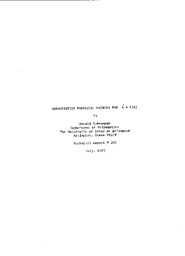
ATTENTION: The works hosted here are being migrated to a new repository that will consolidate resources, improve discoverability, and better show UTA's research impact on the global community. We will update authors as the migration progresses. Please see MavMatrix for more information.
Show simple item record
| dc.contributor.author | Greenspan, Donald | en |
| dc.date.accessioned | 2010-06-03T17:56:24Z | en |
| dc.date.available | 2010-06-03T17:56:24Z | en |
| dc.date.issued | 1983-07 | en |
| dc.identifier.uri | http://hdl.handle.net/10106/2318 | en |
| dc.description.abstract | **Please note that the full text is embargoed** ABSTRACT: Physics is characterized by conservation laws and by symmetry [1]. Unfortunately, the application of numerical methodology in
approximating solutions of initial value problems usually does not preserve either of these invariants. In this sense, the use of a computer destroys the physics of a dynamical model. We will show here how to conserve total energy when solving the nonlinear initial value problem [see pdf for notation] on a computer. Moreover,
the energy conserved will be exactly that of (1.1), not a new "energy" which is defined by the numerical method (see, e.g., Langdon [5]). Two distinctly different methods will be developed, one of which is completely conservative and symmetric, the other of which reveals how to convert
any numerical method to an energy conserving one. | en |
| dc.language.iso | en_US | en |
| dc.publisher | University of Texas at Arlington | en |
| dc.relation.ispartofseries | Technical Report;205 | en |
| dc.subject | Numerical methodology | en |
| dc.subject | Physics | en |
| dc.subject | Nonlinear initial value problem | en |
| dc.subject.lcsh | Mathematics Research | en |
| dc.title | Conserving Numerical Methods for x = f(x) | en |
| dc.type | Technical Report | en |
| dc.publisher.department | Department of Mathematics | en |
Files in this item
- Name:
- MathTechReport205.pdf
- Size:
- 1017.Kb
- Format:
- PDF
- Description:
- PDF
This item appears in the following Collection(s)
Show simple item record


